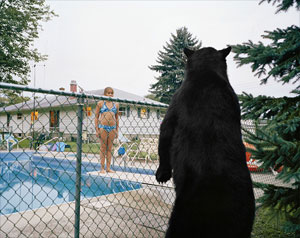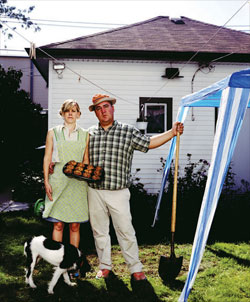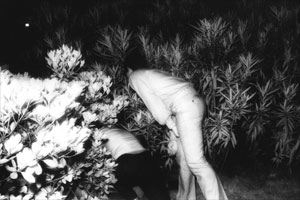Beyond the Backyard

About the Exhibition
Featuring work by:
Manuel Alvarez Bravo
Harry Callahan
William Christenberry
Barbara Ciurej and Lindsay Lochman
Paul Clark
Jno Cook
Gregory Crewdson
Mel Curtis
Bruce Davidson
Deanna Dikeman
Todd Deutsch
Larry Fink
Sarah Faust
Meg Gerken
Emmet Gowin
Todd Hido
Dave Jordano
Ken Josephson
Lewis Kostiner
Dorothea Lange
Danny Lyon
Alex S. MacLean
Sally Mann
Stephen Marc
Mary Ellen Mark
Rhondal McKinney
Ralph Eugene Meatyard
Nic Nicosia
Bill Owens
Melissa Ann Pinney
Colleen Plumb
Marc PoKempner
Martha Rosler
Shawn Records
James Rotz
Mike Sinclair
Mike Smith
Alec Soth
Amy Stein
Greg Stimac
Larry Sultan
Tricia Moreau Sweeney
Jack D. Teemer
Brad Temkin
Jerry N. Uelsmann
Harry Wessel, Jr.
Troy Williams
Garry Winogrand
Jeffrey Wolin
Shizuka Yokomizo
Kohei Yoshiyuki
Aristocratic estates in England and France featured the forerunner of the residential yard—manicured lawns as conspicuous luxury—yet the backyard as it is known today is in many ways an American creation. Shaped by the distinctive forms of suburban development in the United States, the residential backyard has become a familiar landscape and a cultural phenomenon with widely recognized contours, from ideas about what backyards typically look like to the activities and cultural meanings we commonly associate with them. Between 1920 and 1930, the United States experienced the first intense episode of suburban development, which established a new kind of residential living, centered on the single-family home on a spacious lot. From the start these houses ideally featured a yard in both the front and back, enforcing a hierarchy of public and private spaces as well as an appeal to a detached, selective relationship with the world outside. Starting shortly after World War II,however, the nation experienced a second, more dramatic suburban expansion, fueled by government policy, rising per capita wealth, and an influx of soldiers returning from the war.
Shaped by the distinctive forms of suburban development in the United States, the residential backyard has become a familiar landscape and a cultural phenomenon with widely recognized contours, from ideas about what backyards typically look like to the activities and cultural meanings we commonly associate with them.
This development was informed by shifting cultural and social values, most notably in ideas about nature and the perceived ills of urban living, but also by a burgeoning notion of family togetherness—the vision of husband, wife, and children spending their leisure time together. The conventional view of the backyard embodies these converging values, and during this period its role shifted from being a decorative backdrop to a place integrated with daily life. In this regard, the backyard is traditionally conceived of as a peaceful, private space in which to spend leisure time and develop a relationship with the natural world, with minimal intrusion from outsiders. (1)
Photographers have found moments of family togetherness in the backyard to be a compelling subject for at least fifty years, as one discovers in Dorothea Lange’s photographs of Mormon towns in the 1950s. More recently backyards have played a part in depictions of idyllic versions of family life, appearing as largely reassuring settings, as seen in both Meg Gerken’s pictures from the Changing Chicago Project in the 1980s and Melissa Ann Pinney’s ongoing series of photographs of her daughter. Sociologists have observed that confidence in the American vision of the ideal family life hit its highest point in the 1950s, but it continues to be a beckoning horizon today, even if this ideal is widely recognized to be fundamentally elusive. A number of artists working in a documentary style, such as Larry Sultan and Todd Deutsch, have engaged with the ups and downs of domestic life while grappling with the fact that the atomized environment of suburbia might, in the end, undermine familial harmony.
The backyard is traditionally conceived of as a peaceful, private space in which to spend leisure time and develop a relationship with the natural world, with minimal intrusion from outsiders.
Other artists have aimed more pointedly at the ideological aspects of this schema of family life, such as embedded gender roles. Martha Rosler’s early Super-8 films The Backyard Economy I and II (both 1974) follow a woman completing various domestic tasks, such as hanging laundry and mowing the lawn. The backyard has gradually become naturalized, its patterns and conventions taken for granted, but Rosler, in making these mundane activities the very substance of her art, foregrounds the labor that allows for moments of leisure and with it the tacit economy of the backyard.
Dave Jordano and Shawn Records also document ordinary activities and settings, but each of them focuses on more idiosyncratic expressions that suggest deeper cultural significance. A number of Jordano’s photographs allude to the fact that the manicured lawn is such a familiar presence in the United States that Americans have difficulty envisioning an alternative landscape, reminding us that the turf-grass lawn is an aesthetic norm. Shawn Records’ photographs bring into relief how the backyard represents a desire to live with nature on our own terms, and in a controlled setting. The landscapes in his photographs are peaceful and even pretty, but they carry a quiet undercurrent of violence: in one the boughs of a once-living tree are replaced by flowerpots, while in another the backyard is punctuated by imposing fences.
A number of artists working in a documentary style…have engaged with the ups and downs of domestic life while grappling with the fact that the atomized environment of suburbia might, in the end, undermine familial harmony.
Many of the photographs in the exhibition focus on traditional backyards in small towns and suburbs. A few artists, however, document the backyard in more urban settings, where it is less common and where it takes on different forms. A number of Brad Temkin’s photographs depict lush gardens in walled-in backyards in Chicago, a series of enclaves within the seemingly inhospitable city. In contrast, Jack Teemer and James Rotz show grittier backyard environments in ailing metropolises like Baltimore and the industrial suburbs of northern Indiana, respectively. Just as commonly, though public squares or parks become alternatives to the backyard. Marc PoKempner’s photographs around one of Chicago’s public housing projects and Stephen Marc’s photographs of South Side neighborhoods, both from the 1980s, present sites of communal recreation and families gathered outside of their apartments. Although the images reveal intermittent signs of the inequalities that grew out of government policy on urban development, these particular residents appear as content in their outdoor spaces as the suburbanites do in their backyards.
Nonetheless, in these more public settings different dynamics or expectations of privacy and exposure emerge. The photographs in Kohei Yoshiyuki’s series The Park (1971-73) provide visceral illustrations. Photographing in three Tokyo parks at night using infrared film, Yoshiyuki reveals amorous couples in the grass under the cover of darkness, but he focuses equally on the numerous voyeurs watching from close by.
These documentary projects begin to suggest the diversity of backyards, but they also subtly undermine the backyard’s privileged position in suburban mythology. In the heyday of suburbia in the 1970s, Bill Owens completed a groundbreaking study of suburban living in Livermore, California, where he worked as a staff photographer for the local newspaper. His images present what now appear as quintessential backyard activities, such as Sunday afternoon barbecues and watering the lawn, demonstrating the longevity of our ideas of backyard life, and their association with a suburban lifestyle. Owens has said, the people he met “enjoy the lifestyle of the suburbs. They have realized the American Dream,” and at first blush his pictures assert a rosy ideal made tangible. (2) In the end, though, Owens’s photographs, while exuberant and largely optimistic, reveal a deadpan sense of humor and an occasionally confounding mix of empathy and irony: what first appears as an ideal can take on tarnished or even farcical manifestations.
The backyard is more than a place; it is also a social norm , reinforced by advertising and media imagery over half a century.
The backyard is more than a place; it is also a social norm, reinforced by advertising and media imagery over half a century. In the 1950s the influential picture magazines Life and Look promoted the now-familiar forms of the backyard as a vital component of suburban living, and these ideas are still asserted today in popular culture, from television sitcoms to advertising campaigns. A number of artists inBeyond the Backyard turn to constructed representations themselves: staging scenes for the camera or manipulating their images, they foster parallels between the ways a photograph can be constructed and the ways in which the backyard is a cultural construction.
In her series Domesticated (2005), Amy Stein re-creates real encounters between people and wildlife in small town Pennsylvania, based on newspaper reports and personal stories. In her meticulously staged photographs wild animals appear at the threshold of the backyard, where they take on the character of voyeurs or prowlers. The borders of the backyard ostensibly separate public and private realms, but Stein’s work accentuates the fact that these boundaries are unstable and vulnerable to intrusion or outside scrutiny.
Shizuka Yokomizo confronts the viewer with a visceral record of actual voyeuristic encounters between people in a residential setting. For her series Stranger (1998-2000) Yokomizo sent an anonymous letter to each of her subjects, asking them to stand in one of their windows at a designated time at night so she could photograph them from outside. Her pictures remind us that whether or not one knows the neighbors, they might be watching you at any time. Although her photographs exist as records of specific encounters, the frisson of Yokomizo’s images emerges from their performative aspect: the artist, poised in the shadows with her camera, effectively brought to life the disconcerting trope of the voyeur for her uneasy subjects, who willingly pose for her within their homes.
In the series Public Displays of Affection, Tricia Moreau Sweeney also depicts private moments in the domestic sphere that are brought into public view. In her photographs pairs of people are intertwined—in urban yards but visible to passersby—in what could be either sexual embraces or violent brawls. It is difficult to pinpoint the nature of these interactions, but equally hard to determine if the photographs are documents of events Sweeney stumbled across fortuitously or small dramas she has produced for the camera. Examining the conventional divisions between public and private life, Sweeney shows that the backyard might not readily align with either. At the same time, she introduces a correspondence between the ambiguity of the backyard space and the ambiguities of the photograph record.
Gregory Crewdson enacts scenarios on the large scale of a feature film, and his photographs mine the hidden anxieties and mysteries of small town American life. In UT (_overturned schoolbus_, 2001-02), Crewdson portrays a smoking, wrecked school bus, surrounded by a cluster of unattended children. The scene is as enigmatic as it is ominous, but it seems to reify the notion—or at least the parents’ “common fear” that danger rather than adventure waits outside of the protected confines of the yard. Crewdson has described his interest as “ordinary life and the uncanny,” that strange coming together of reality and fiction. (3)
He strives for a sense of transparency in his photographs, as if one might step into the image he creates, while exploring how the fictions at play in everyday life resonate with the nature of photographs as particular views of reality.
Nic Nicosia also invites us to think about photography’s relationship with ideas of truth and fiction. In Real Pictures #11(1988/1992) Nicosia presents three kids burning down a tree in the backyard. This situation challenges the notion that the yard is a place where children can play safely, watched by a parent, and it takes the recurring tension between nature and people in the backyard to a dramatic climax. Just as notably, Nicosia emphasizes our persistent faith in the photograph as a reliable document. Using the rhetorical strategies of documentary photography he establishes a feeling of realism while portraying a sensational event that pushes the limits of credibility.
Drawn mainly from the museum’s permanent collection and its Midwest Photographers Project and featuring over forty artists, Beyond the Backyard provides a range of perspectives on the backyard.
Drawn mainly from the museum’s permanent collection and its Midwest Photographers Project and featuring over forty artists,Beyond the Backyard provides a range of perspectives on the backyard. The place of the residential yard in American culture appears as sturdy as ever and many of the artists in this exhibition demonstrate its enduring appeal. Others, however, complicate or question the traditional, often-idealized notion of the backyard, the private space. A number of these photographers more explicitly draw the medium of photography itself into the equation, highlighting parallels between photographic constructions and the cultural construction of the backyard. In the end, then, the exhibition might invite each of us to consider how our own experiences of backyards align with—or diverge from—the frequent advertising and media representations of this seemingly well-known place.
—Karsten Lund, Collection Research Fellow
(1) For more about suburban development and changing views of the residential yard, see Kenneth Jackson, The Crabgrass Frontier: The Suburbanization of the United States, (New York: Oxford University Press, 1985); Tom Martinson, American Dreamscape: The Pursuit of Happiness in Postwar Suburbia, (New York: Carroll and Graf Publishers, Inc., 2000); and Peter G. Rowe, Making a Middle Landscape (Cambridge, Mass. and London: MIT Press, 1991). For more on family togetherness, see Laura J. Miller, “Family Togetherness and the Suburban Ideal,” Sociological Forum, vol. 10, no. 3 (September 1995).
(2) Quoted in James Guimond, American Photography and the American Dream, (Chapel Hill & London: University of North Carolina Press, 1991), p. 263.
(3) Gregory Crewdson, Aperture, no. 190 (Spring 2008). Web-exclusive: https://www.aperture.org/crewdson/. Accessed April 16, 2008.
For Beyond the Backyard, the MoCP is partnering with Openlands, a non-profit organization dedicated to preserving and enhancing public open space in northeastern Illinois, and the Peggy Notebaert Nature Museum, presenting Lawn Nation: Art and Science of the American Lawn from May 23 through September 27, 2008.
Support for Beyond the Backyard is generously provided by Ogilvy and William Blair & Company.
Image Gallery


